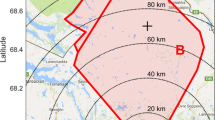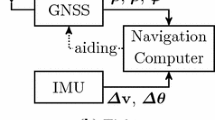Abstract
European space launch operators consider the potential of GNSS (global navigation satellite system) as a promising novel means of localization for the purpose of range safety of launch vehicles like Ariane and Vega, since it is expected that recurring costs are lower and accuracy is higher than currently existing systems like radar tracking. Range safety requires continuous information about the position and velocity of the launch vehicle to quickly detect the occurrence of catastrophic events. However, GNSS outages due, for example, to high jerks at fairing and stage jettisons or other external interferences like (un-)intentional jamming cannot be precluded. The OCAM-G experiment on Ariane 5 flight VA219 has provided evidence that GNSS is capable of providing a highly accurate position and velocity solution during most of the flight, but that outages of several seconds do occur. To increase the continuity of a GNSS-based localization system, it is proposed that the GNSS receiver is augmented by an inertial measurement unit (IMU), which is able to output a position and velocity solution even during GNSS outages. Since these outages are expected to be short, a tactical- or even consumer-grade IMU is expected to be sufficient. In this paper, the minimum IMU performance that is required to bridge outages of up to 10 s, and thereby meeting the accuracy requirements of range safety, is determined by means of a thorough simulation study. The focus of the analysis is on current generation microelectromechanical system (MEMS)-based IMU, which is lightweight, low-cost, available commercially and has reached acceptable maturity in the last decade.



























Similar content being viewed by others
References
Giannini M., Melara M., Roux, C.: ALTS localization system of Vega launcher: VV02 Post-flight analysis & GPS issues for future hybrid navigation. In: Proceedings of the 9th International ESA Conference on Guidance, Navigation & Control Systems, Porto, Portugal (2014)
Hauschild A., Markgraf M., Montenbruck O., Pfeuffer H., Rmili B., Dawidowicz, E., Conde Reis, A.: Results of the GNSS receiver experiment OCAM-G on Ariane-5 flight VA 219. In: Proceedings of the 6th European Conference for Aeronautics and Space Sciences (EUCASS), Krakow, Poland (2015)
Belin, S., Reynaud, S., Dubuc, F., Floch, J. J., Polle, B., Resta, P. D.: Use of Galileo for launch services application. In: Proceedings of the 7th International ESA Conference on Guidance, Navigation & Control, Tralee, Ireland (2008)
Narmada, Reynaud, S., Delaux, P., Biard, A.: Use of GNSS for next European launcher generation. In: Proceedings of the 6th International ESA Conference on Guidance, Navigation and Control Systems, Loutraki, Greece (2005)
Broquet, R., Perrimon, N., Polle, B., Hyounet, P., Drai, R., Voirin, T., Krauss, P. A., Fernandez, V.: HiNAV inertial / GNSS hybrid navigation system for launchers and re-entry vehicles. In: Proceedings of the 5th ESA Workshop on Satellite Navigation Technologies and European Workshop on GNSS Signals and Signal Processing (NAVITEC), Noordwijk, The Netherlands (2010)
Polle, B., Frapard, B., Reynaud, S., Belin, S., Krauss, P. A., Zangerl, F., Penin, L. F., Fernandez, F., D’Angelo, P., Drai, R., Voirin, T.: Robust INS/GPS hybrid navigator demonstrator design for launch, re-entry and orbital vehicles. In: Proceedings of the 7th International ESA Conference on Guidance, Navigation & Control Systems, Tralee, Ireland (2008)
Committee on Space Launch Range Safety: Streamlining space launch range safety. National Academic Press, Washington (2000)
Range Safety Office: Patrick air force base: range user handbook. EWR127-1 (1997)
Range Commanders Council: global positioning and inertial measurement range safety tracking systems’ commonality standard. RCC 324-01 (2001)
Moore, T. C., Li, H., Gray, T., Doran, A.: Launch vehicle tracking enhancement through global positioning system metric tracking. In: Proceedings of the IEEE Aerospace Conference, Big Sky, Massachusetts (2013). doi:10.1109/AERO.2013.6496829
Burke E., Rutkowski, E.: Vehicle based independent tracking system (VBITS): a small, modular, avionics suite for responsive launch vehicle and satellite applications. In: Proceedings of the AIAA 6th Responsive Space Conference, Los Angeles, California (2008)
Bull, J. B., Lamzi, R. J.: An autonomous flight safety system. In: Proceedings of the AIAA Missile Sciences Conference, Monterey, California (2008)
NASA Tech Briefs: Range safety for an autonomous flight safety system. GSC-15594-1 (2010)
Gruss, M.: ORS-3 launch tested new ATK-developed flight safety system. Space News, 27 November 2013. http://spacenews.com/38387ors-3-launch-tested-new-atk-developed-flight-safety-system/. Accessed 22 June 2015
Conde Reis, A., Fricke, G., Pfeuffer, H., Soviche, A., Astier, V., Rmili, B.: Onboard video telemetry for european launchers. In: Proceedings of the AIAA SpaceOps 2010 Conference, Huntsville, Alabama (2010)
Septentrio: SBF reference guide (2010)
Arianespace: Ariane 5 user’s manual. issue 5, revision 1 (2011)
Rousseau, S., Walmsley, G., Agnese, J.-C., Rubio, J.-C., Voyer, J.-L.: Ariane 5 launch, first step of ATV’s long trip to the ISS. In: Proceedings of the AIAA SpaceOps 2010 Conference, Huntsville, Alabama (2010)
Goodwin, A., Davies P., Harborne, J.: SCTV: ground-based trajectography system for tracking ariane launchers. In: Proceedings of the 12th International Symposium on Space Flight Dynamics, Darmstadt, Germany (1997)
CNES: Besoin sur les Moyens de Localisatin pur la Sauvegarde (2014)
Simon, D.: Optimal state estimation, John Wiley & Sons (2006)
Steffes, S. R.: Development and analysis of SHEFEX-2 hybrid navigation system experiment. Dissertation, Universität Bremen (2013)
Montenbruck, O., Markgraf, M.: Global positioning system sensor with instantaneous-impact-point prediction for sounding rockets. J. Spacecr. Rockets 41(4), 644–650 (2004). doi:10.2514/1.1962
Di Giovanni, G., Radicella, S.M.: An analytical model of the electron density profile in the ionosphere. Adv. Space Res. 10(11), 27–30 (1990)
Radicella, S.M.: The NeQuick model genesis, uses and evolution. Ann. Geophy. 52(3), 417–422 (2009)
Collins, J., Langley, R.: A tropospheric delay model for the user of the wide area augmentation system (1997)
Benet, X. L.: Study of the performance of an inertial measurement unit on board a launcher. Project report, Universitat Politècnica de Catalunya, Barcelona, Spain (2014)
Analog Devices: Low profile six degree of freedom inertial SensorADIS16334. Rev. B. http://www.analog.com/media/en/technical-documentation/data-sheets/ADIS16334.pdf. Accessed 1 July 2015
Analog Devices: Tactical grade, six degrees of freedom inertial sensor ADIS16485. Rev. E. http://www.analog.com/media/en/technical-documentation/data-sheets/ADIS16485.pdf. Accessed 1 July 2015
Silicon Sensing: DMU10 six degrees of freedom precision MEMS inertial measurement unit technical datasheet. 2015, Rev. 3. http://www.siliconsensing.com/media/560351/DMU10-00-0100-132_3_PDF_SSS_-.pdf. Accessed 1 July 2015
Silicon Sensing: Angular rate and dual-axis linear acceleration Combi-SensorCMS300 technical datasheet. Rev. 8, 2013. http://www.siliconsensing.com/media/447608/CMS300-00-0100-132_8_PDF_SSS_-.pdf. Accessed 1 July 2015
Sensonor: STIM300 inertia measurement unit datasheet. March 2015, Rev. 19. http://www.sensonor.com/media/99614/ts1524.r19%20datasheet%20stim300.pdf. Accessed 1 July 2015
Northrop Grumman LITEF: μIMU-IC micro inertial measurement unit. March 2013. http://www.northropgrumman.litef.com/fileadmin/downloads/Datenblaetter/Datenblatt_uIMU-IC.pdf. Accessed 1 July 2015
Northrop Grumman LITEF: TPD product description μIMU-I. Rev. B (2012)
Author information
Authors and Affiliations
Corresponding author
Rights and permissions
About this article
Cite this article
Braun, B., Markgraf, M. & Montenbruck, O. Performance analysis of IMU-augmented GNSS tracking systems for space launch vehicles. CEAS Space J 8, 117–133 (2016). https://doi.org/10.1007/s12567-016-0113-9
Received:
Revised:
Accepted:
Published:
Issue Date:
DOI: https://doi.org/10.1007/s12567-016-0113-9




